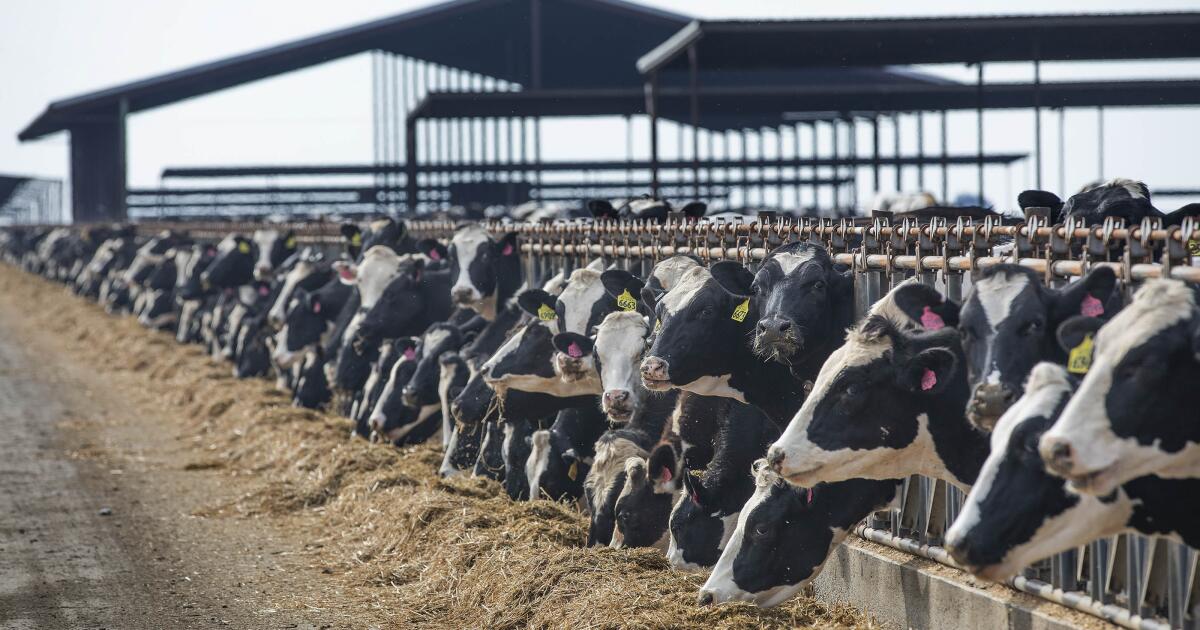The number of California dairy herds reported to have outbreaks of H5N1 bird flu has grown to eight.
Officials have refused to disclose the locations of the infected herds, but have said they are in close proximity somewhere in California’s Central Valley — an 18,000-square-mile expanse that is roughly the size of Vermont and New Hampshire combined.
They say they are still investigating the source of the virus, but at a news conference Thursday, federal officials said genetic sequencing from the first three outbreaks suggests the strain is similar to that seen in other states. They say it does not appear to have been caused by wild birds or animals.
“This is the same virus that we’ve detected in herds since the beginning of the emergence of H5N1 in dairy cows,” said Eric Deeble, deputy under secretary for marketing and regulatory programs at the United States Department of Agriculture. “Sequencing of the samples from the additional five premises will likely be completed later this week or over the weekend.”
He said the California Department of Food and Agriculture has been “conducting a very thorough traceback, and all the herds that have been detected in California to date have been through their investigation.”
There have been 201 herds infected by the virus across 14 states since the outbreak was first reported in March.
State officials continue to reassure the public that the risk to the general population is low, and that pasteurized milk and dairy products are safe for human consumption.
Deeble said his agency is in the process of authorizing field safety studies for a H5N1 cow vaccine.
An agency spokesman said vaccine development does not suggest that the biosecurity protocols that the USDA and state governments have followed have failed. Nor does it mean the virus is here to stay.
“Vaccine development is one part of an overall strategy that includes enhanced and strengthened biosecurity efforts to contain the virus and help mitigate spread,” said Will Clement, a USDA spokesman.
“Bovine vaccines may prove to be an important tool to eventually help eliminate the virus from the nation’s dairy cattle herd, but developing a vaccine requires many steps and it will take time to test, approve, and distribute a successful vaccine,” he said. “This is why we have opened the pathway to vaccine field trials even as we continue to deploy all available efforts, including emphasizing biosecurity and mandating the testing lactating dairy cattle moving across state lines.”
In addition, federal health officials say they have not been able to sequence the entirety of the H5N1 sample isolated from a human case in Missouri. That person had no known contact with dairy or poultry, and a preliminary investigation has not been able to determine the source of infection.
There have been no reports of infected dairy herds in Missouri.
“Right now, evidence points to this being a one off,” said Nirav Shah, principal deputy director at the Centers for Disease Control and Prevention.
Shah said the patient, who was hospitalized with flu-like symptoms and has since recovered, had only low levels of the virus circulating through their body. As a result, sequencing has been difficult.
While officials can safely say the virus is of the H5 sub-type, they have not been able to sequence the N-part.
But the H5 part appears to resemble the H5 subtype in infected dairy cows.
“We’re throwing everything we’ve got at this, but ultimately, a full sequence may not be technically feasible because of the low concentration of viral RNA,” Shah said.
